Abstract
Formation of bile requires the coordinated function of two epithelial cell types: hepatocytes, that are responsible for secretion of the major osmolytes and biliary constituents and cholangiocytes that regulate the fluidity and alkalinity of bile through secretion of osmolytes such as Cl- and HCO3- Studies in isolated cholangiocyte preparations have elucidated the basic transport mechanisms involved in constitutive and stimulated secretory activities in the biliary epithelium. Basolateral Na+/H+ exchanger and Na+:HCO3- symporter mediate HCO3- uptake, while an apical cAMP-activated Cl-/HCO3- exchanger secretes bicarbonate into the lumen. Cholangiocytes also possess a cAMP-stimulated Cl- conductance (CFTR) and a Ca-activated Cl- channel, both likely located at the apical membrane. Cholangiocyte secretory functions are regulated by a complex network of hormones mainly acting via the cAMP system. In addition, recent data indicate that part of the regulation of ductular secretion may take place at the apical membrane of the cholangiocyte through factors present into the bile, such as ATP, bile acids and glutathione. Primary damage to the biliary epithelium is the cause of several chronic cholestatic disorders (cholangiopathies). From a pathophysiological point of view, common to all cholangiopathies is the coexistance of cholangiocyte death and proliferation and various degrees of portal inflammation and fibrosis. Cholestasis dominates the clinical picture and, pathophysiologically, may initiate or worsen the process. Alterations in biliary electrolyte transport could contribute to the pathogenesis of cholestasis in primary bile duct diseases. Cystic Fibrosis-related liver disease represents an example of biliary cirrhosis secondary to a derangement of cholangiocyte ion transport. Most primary cholangiopaties recognize an immune-mediated pathogenesis. Cytokines, chemokines, and proinflammatory mediators released in the portal spaces or produced by the cholangiocyte itself, likely activate fibrogenesis, stimulate apoptotic and proliferative responses, and alter the transport functions of the epithelium.
Full text
PDF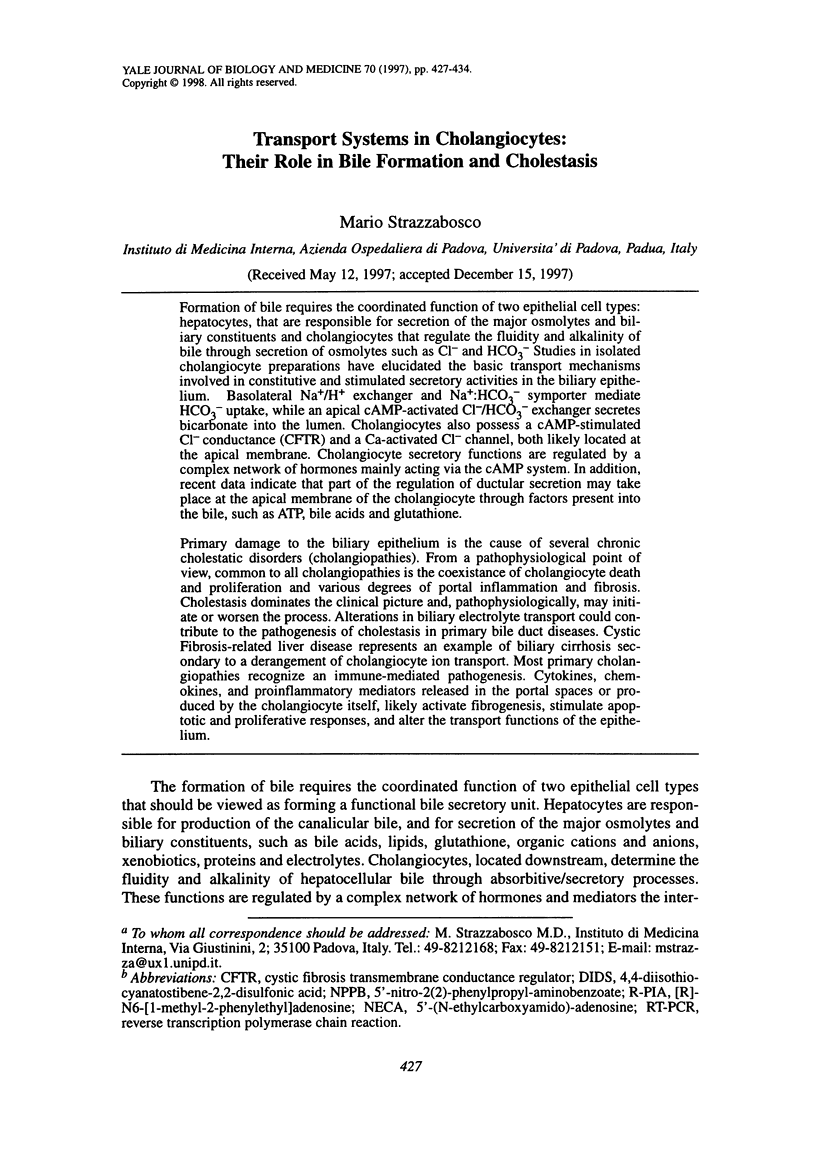
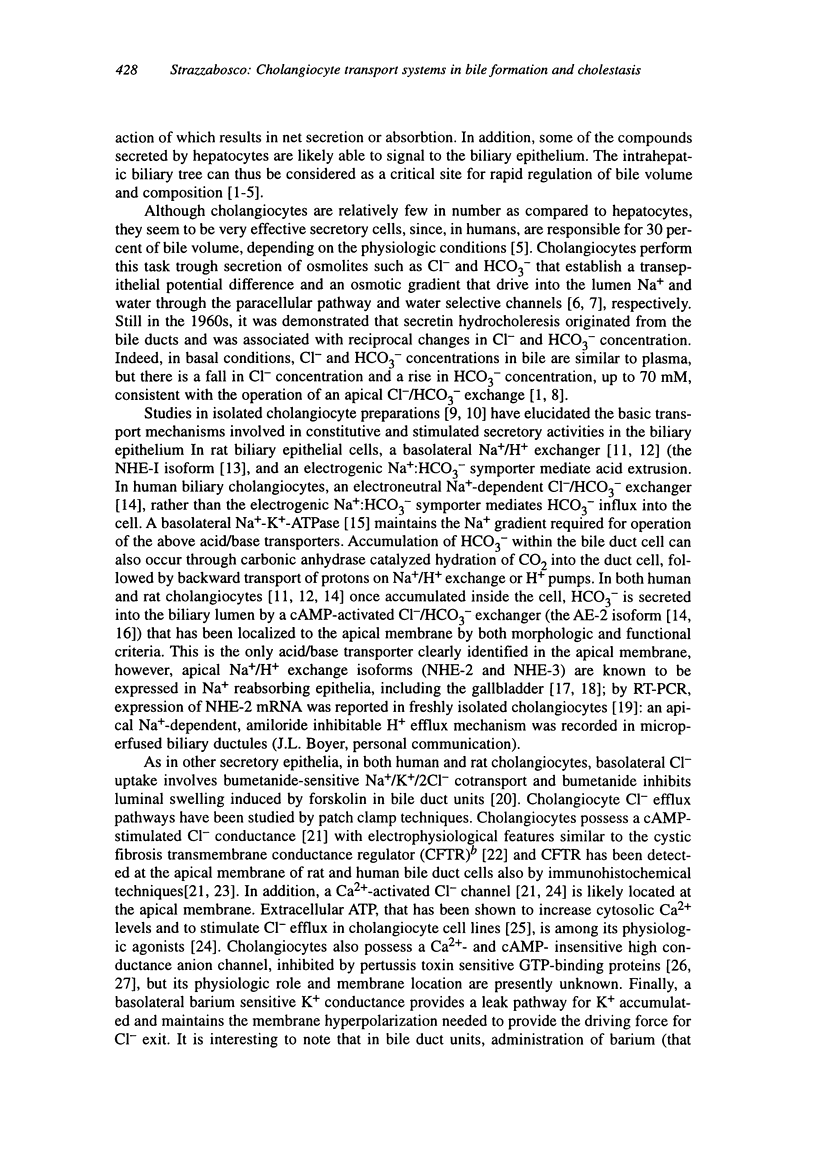
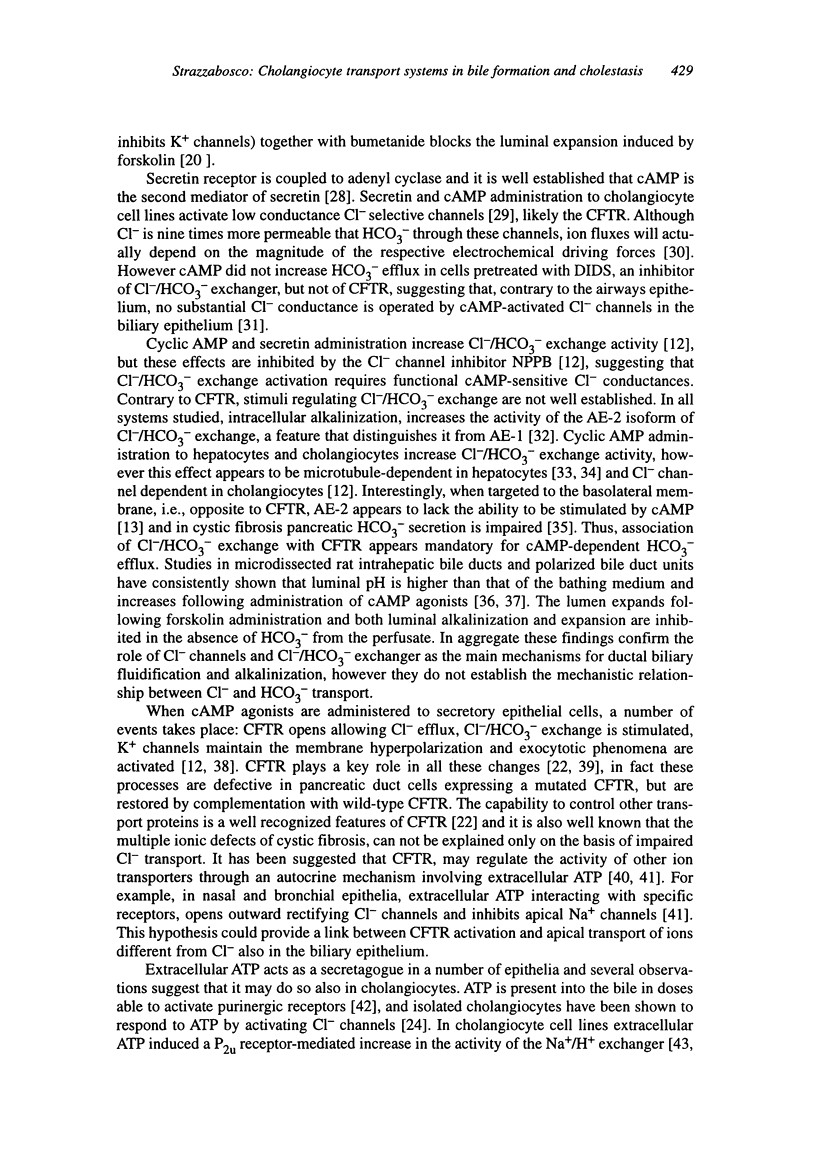
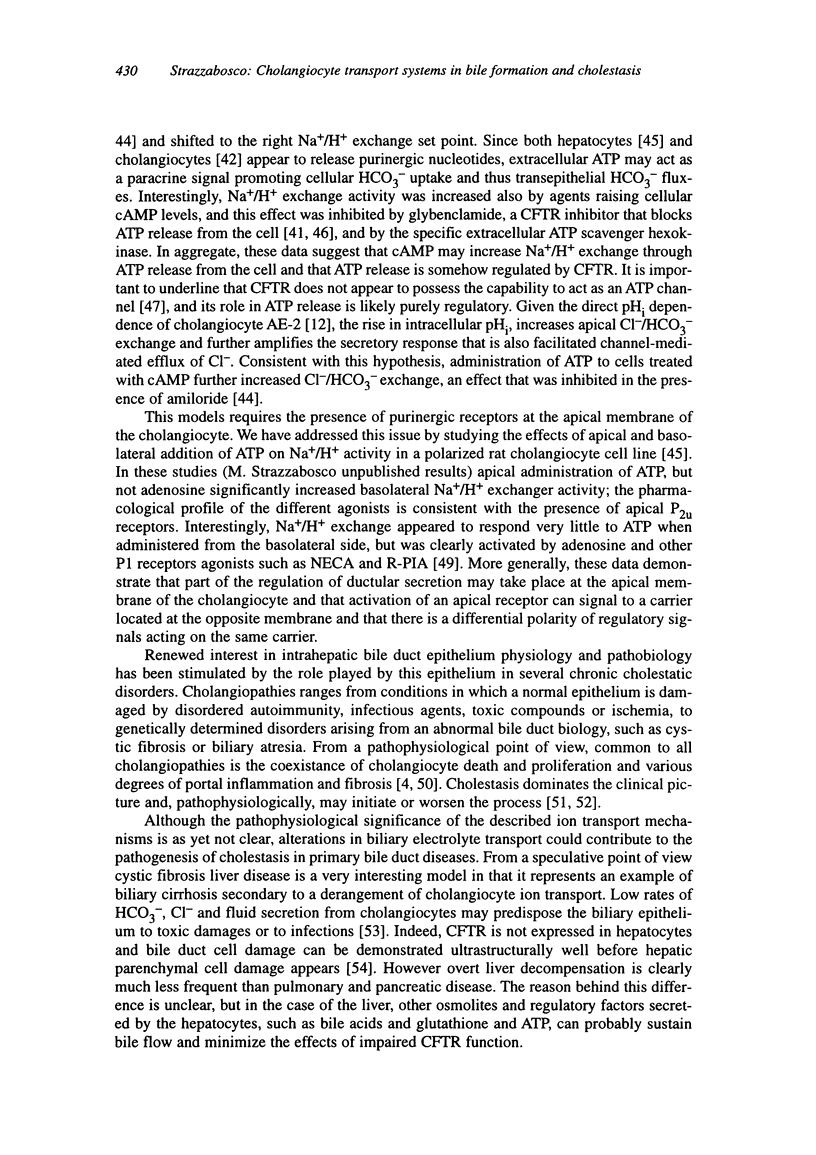
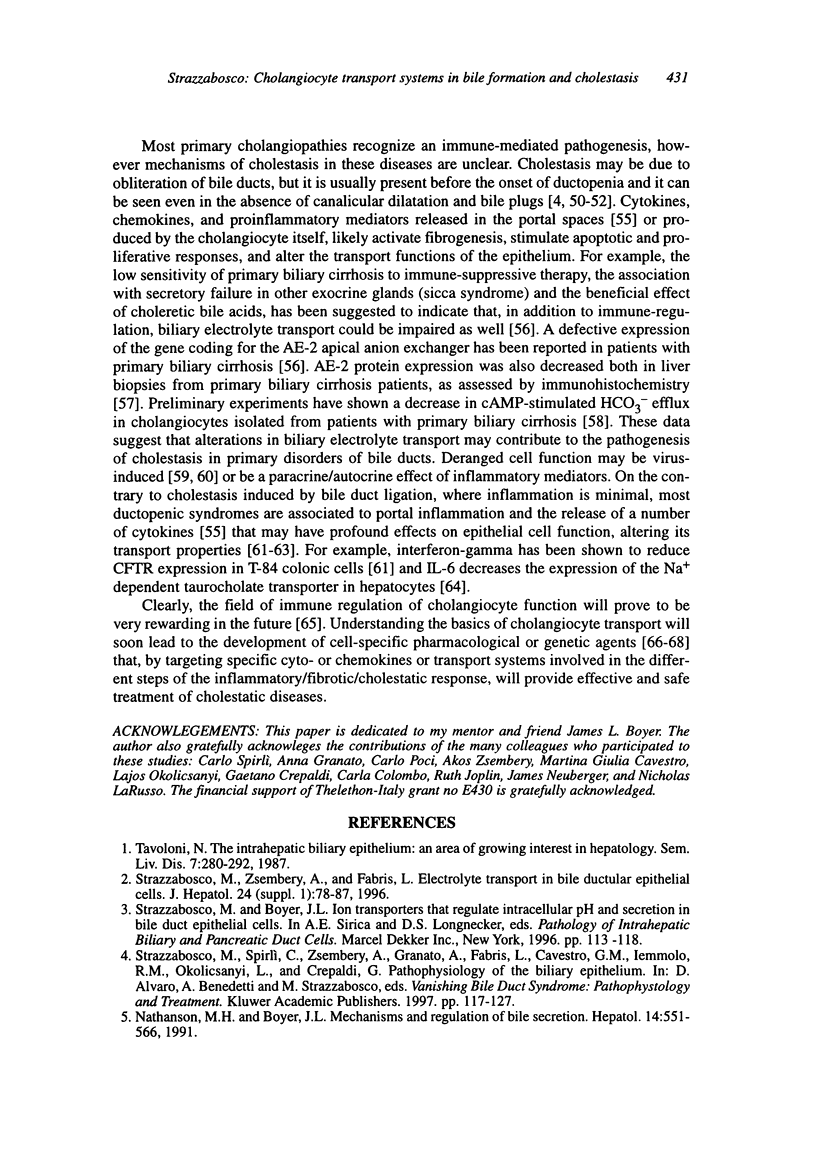
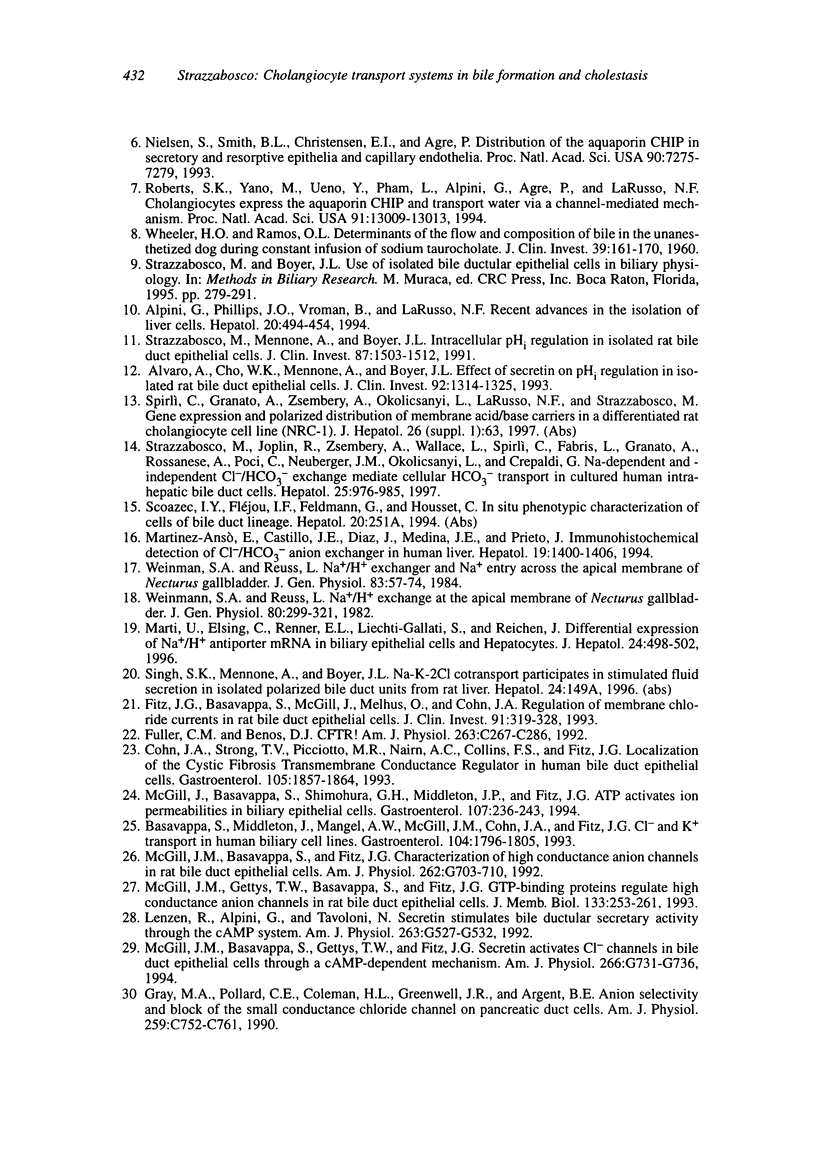
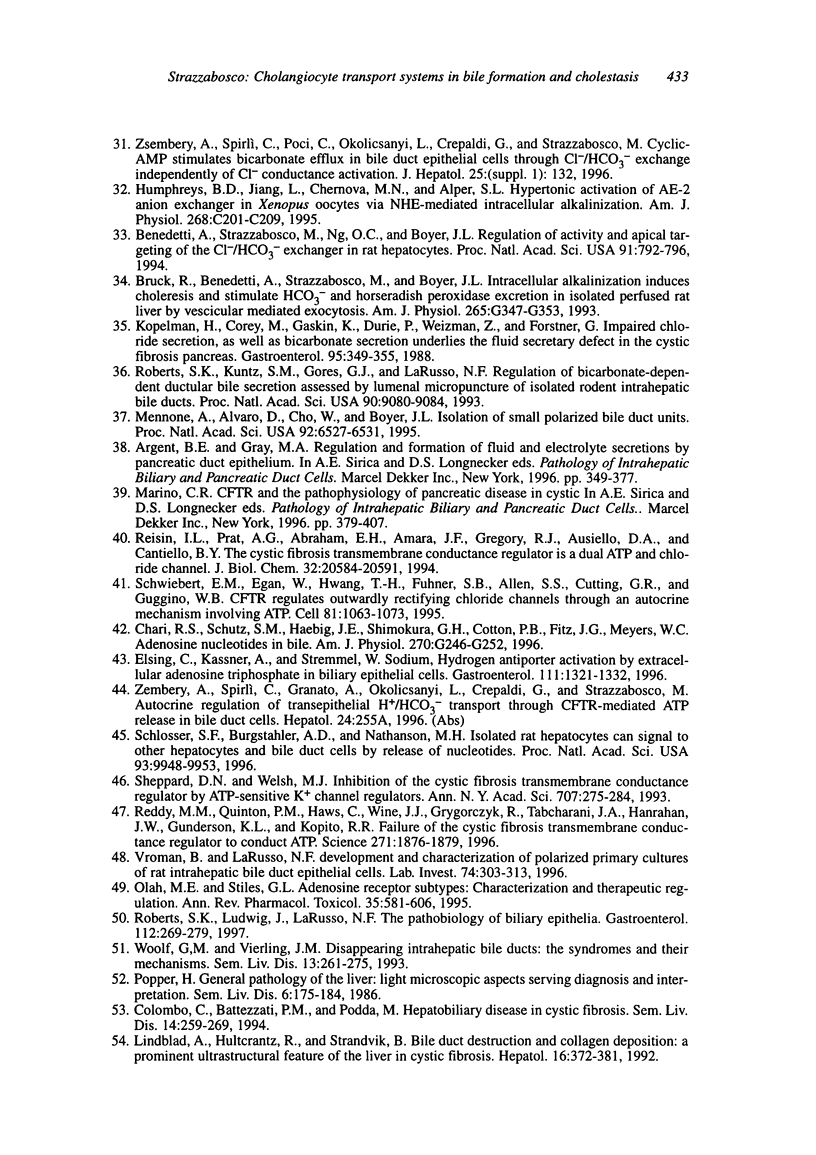
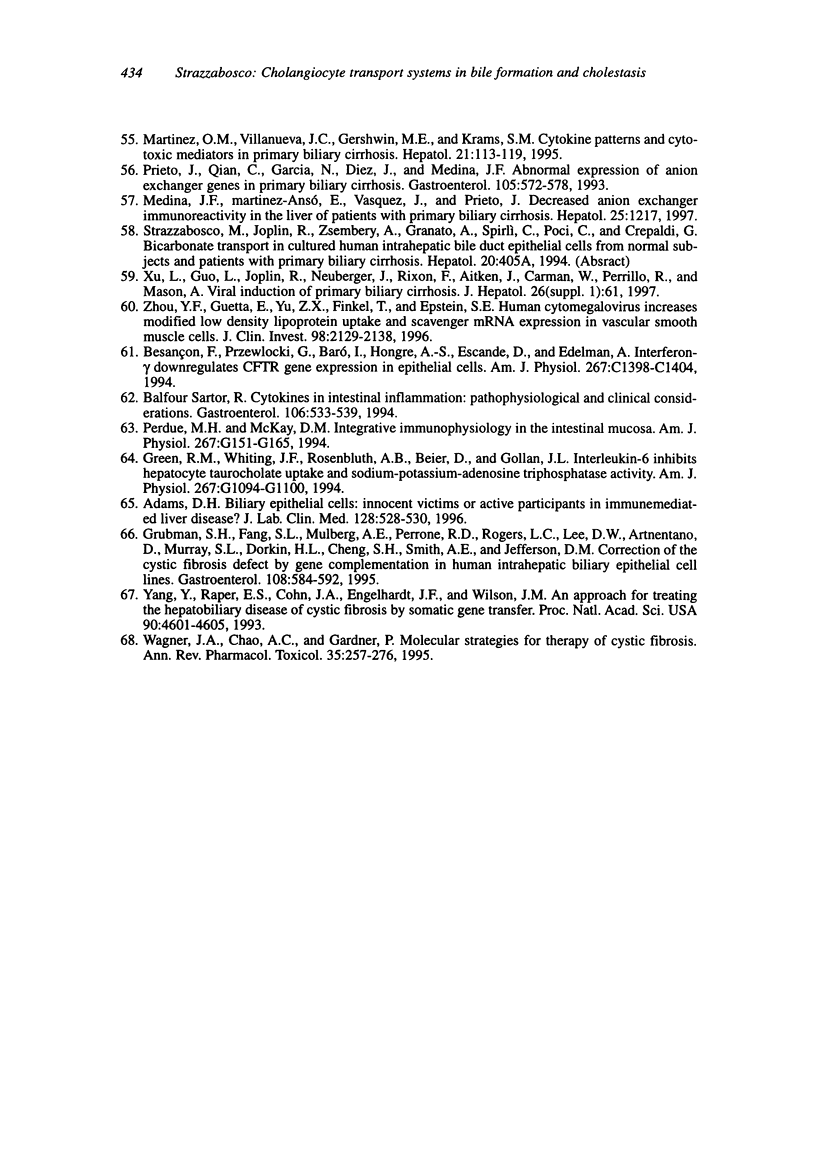
Selected References
These references are in PubMed. This may not be the complete list of references from this article.
- Adams D. H. Biliary epithelial cells: innocent victims or active participants in immune-mediated liver disease? J Lab Clin Med. 1996 Dec;128(6):528–530. doi: 10.1016/s0022-2143(96)90123-7. [DOI] [PubMed] [Google Scholar]
- Alpini G., Phillips J. O., Vroman B., LaRusso N. F. Recent advances in the isolation of liver cells. Hepatology. 1994 Aug;20(2):494–514. [PubMed] [Google Scholar]
- Alvaro D., Cho W. K., Mennone A., Boyer J. L. Effect of secretion on intracellular pH regulation in isolated rat bile duct epithelial cells. J Clin Invest. 1993 Sep;92(3):1314–1325. doi: 10.1172/JCI116705. [DOI] [PMC free article] [PubMed] [Google Scholar]
- Basavappa S., Middleton J., Mangel A. W., McGill J. M., Cohn J. A., Fitz J. G. Cl- and K+ transport in human biliary cell lines. Gastroenterology. 1993 Jun;104(6):1796–1805. doi: 10.1016/0016-5085(93)90661-u. [DOI] [PubMed] [Google Scholar]
- Benedetti A., Strazzabosco M., Ng O. C., Boyer J. L. Regulation of activity and apical targeting of the Cl-/HCO3- exchanger in rat hepatocytes. Proc Natl Acad Sci U S A. 1994 Jan 18;91(2):792–796. doi: 10.1073/pnas.91.2.792. [DOI] [PMC free article] [PubMed] [Google Scholar]
- Besançon F., Przewlocki G., Baró I., Hongre A. S., Escande D., Edelman A. Interferon-gamma downregulates CFTR gene expression in epithelial cells. Am J Physiol. 1994 Nov;267(5 Pt 1):C1398–C1404. doi: 10.1152/ajpcell.1994.267.5.C1398. [DOI] [PubMed] [Google Scholar]
- Chari R. S., Schutz S. M., Haebig J. E., Shimokura G. H., Cotton P. B., Fitz J. G., Meyers W. C. Adenosine nucleotides in bile. Am J Physiol. 1996 Feb;270(2 Pt 1):G246–G252. doi: 10.1152/ajpgi.1996.270.2.G246. [DOI] [PubMed] [Google Scholar]
- Cohn J. A., Strong T. V., Picciotto M. R., Nairn A. C., Collins F. S., Fitz J. G. Localization of the cystic fibrosis transmembrane conductance regulator in human bile duct epithelial cells. Gastroenterology. 1993 Dec;105(6):1857–1864. doi: 10.1016/0016-5085(93)91085-v. [DOI] [PubMed] [Google Scholar]
- Colombo C., Battezzati P. M., Podda M. Hepatobiliary disease in cystic fibrosis. Semin Liver Dis. 1994 Aug;14(3):259–269. doi: 10.1055/s-2007-1007316. [DOI] [PubMed] [Google Scholar]
- Elsing C., Kassner A., Stremmel W. Sodium, hydrogen antiporter activation by extracellular adenosine triphosphate in biliary epithelial cells. Gastroenterology. 1996 Nov;111(5):1321–1332. doi: 10.1053/gast.1996.v111.pm8898647. [DOI] [PubMed] [Google Scholar]
- Fitz J. G., Basavappa S., McGill J., Melhus O., Cohn J. A. Regulation of membrane chloride currents in rat bile duct epithelial cells. J Clin Invest. 1993 Jan;91(1):319–328. doi: 10.1172/JCI116188. [DOI] [PMC free article] [PubMed] [Google Scholar]
- Fuller C. M., Benos D. J. CFTR! Am J Physiol. 1992 Aug;263(2 Pt 1):C267–C286. doi: 10.1152/ajpcell.1992.263.2.C267. [DOI] [PubMed] [Google Scholar]
- Gray M. A., Pollard C. E., Harris A., Coleman L., Greenwell J. R., Argent B. E. Anion selectivity and block of the small-conductance chloride channel on pancreatic duct cells. Am J Physiol. 1990 Nov;259(5 Pt 1):C752–C761. doi: 10.1152/ajpcell.1990.259.5.C752. [DOI] [PubMed] [Google Scholar]
- Green R. M., Whiting J. F., Rosenbluth A. B., Beier D., Gollan J. L. Interleukin-6 inhibits hepatocyte taurocholate uptake and sodium-potassium-adenosinetriphosphatase activity. Am J Physiol. 1994 Dec;267(6 Pt 1):G1094–G1100. doi: 10.1152/ajpgi.1994.267.6.G1094. [DOI] [PubMed] [Google Scholar]
- Grubman S. A., Fang S. L., Mulberg A. E., Perrone R. D., Rogers L. C., Lee D. W., Armentano D., Murray S. L., Dorkin H. L., Cheng S. H. Correction of the cystic fibrosis defect by gene complementation in human intrahepatic biliary epithelial cell lines. Gastroenterology. 1995 Feb;108(2):584–592. doi: 10.1016/0016-5085(95)90089-6. [DOI] [PubMed] [Google Scholar]
- Humphreys B. D., Jiang L., Chernova M. N., Alper S. L. Hypertonic activation of AE2 anion exchanger in Xenopus oocytes via NHE-mediated intracellular alkalinization. Am J Physiol. 1995 Jan;268(1 Pt 1):C201–C209. doi: 10.1152/ajpcell.1995.268.1.C201. [DOI] [PubMed] [Google Scholar]
- Kopelman H., Corey M., Gaskin K., Durie P., Weizman Z., Forstner G. Impaired chloride secretion, as well as bicarbonate secretion, underlies the fluid secretory defect in the cystic fibrosis pancreas. Gastroenterology. 1988 Aug;95(2):349–355. doi: 10.1016/0016-5085(88)90490-8. [DOI] [PubMed] [Google Scholar]
- Lenzen R., Alpini G., Tavoloni N. Secretin stimulates bile ductular secretory activity through the cAMP system. Am J Physiol. 1992 Oct;263(4 Pt 1):G527–G532. doi: 10.1152/ajpgi.1992.263.4.G527. [DOI] [PubMed] [Google Scholar]
- Lindblad A., Hultcrantz R., Strandvik B. Bile-duct destruction and collagen deposition: a prominent ultrastructural feature of the liver in cystic fibrosis. Hepatology. 1992 Aug;16(2):372–381. doi: 10.1002/hep.1840160215. [DOI] [PubMed] [Google Scholar]
- Marti U., Elsing C., Renner E. L., Liechti-Gallati S., Reichen J. Differential expression of Na+,H(+)-antiporter mRNA in biliary epithelial cells and in hepatocytes. J Hepatol. 1996 Apr;24(4):498–502. doi: 10.1016/s0168-8278(96)80172-3. [DOI] [PubMed] [Google Scholar]
- Martinez O. M., Villanueva J. C., Gershwin M. E., Krams S. M. Cytokine patterns and cytotoxic mediators in primary biliary cirrhosis. Hepatology. 1995 Jan;21(1):113–119. [PubMed] [Google Scholar]
- Martínez-Ansó E., Castillo J. E., Díez J., Medina J. F., Prieto J. Immunohistochemical detection of chloride/bicarbonate anion exchangers in human liver. Hepatology. 1994 Jun;19(6):1400–1406. [PubMed] [Google Scholar]
- McGill J. M., Basavappa S., Fitz J. G. Characterization of high-conductance anion channels in rat bile duct epithelial cells. Am J Physiol. 1992 Apr;262(4 Pt 1):G703–G710. doi: 10.1152/ajpgi.1992.262.4.G703. [DOI] [PubMed] [Google Scholar]
- McGill J. M., Basavappa S., Gettys T. W., Fitz J. G. Secretin activates Cl- channels in bile duct epithelial cells through a cAMP-dependent mechanism. Am J Physiol. 1994 Apr;266(4 Pt 1):G731–G736. doi: 10.1152/ajpgi.1994.266.4.G731. [DOI] [PubMed] [Google Scholar]
- McGill J. M., Basavappa S., Mangel A. W., Shimokura G. H., Middleton J. P., Fitz J. G. Adenosine triphosphate activates ion permeabilities in biliary epithelial cells. Gastroenterology. 1994 Jul;107(1):236–243. doi: 10.1016/0016-5085(94)90082-5. [DOI] [PubMed] [Google Scholar]
- McGill J. M., Gettys T. W., Basavappa S., Fitz J. G. GTP-binding proteins regulate high conductance anion channels in rat bile duct epithelial cells. J Membr Biol. 1993 May;133(3):253–261. doi: 10.1007/BF00232024. [DOI] [PubMed] [Google Scholar]
- Mennone A., Alvaro D., Cho W., Boyer J. L. Isolation of small polarized bile duct units. Proc Natl Acad Sci U S A. 1995 Jul 3;92(14):6527–6531. doi: 10.1073/pnas.92.14.6527. [DOI] [PMC free article] [PubMed] [Google Scholar]
- Nathanson M. H., Boyer J. L. Mechanisms and regulation of bile secretion. Hepatology. 1991 Sep;14(3):551–566. [PubMed] [Google Scholar]
- Nielsen S., Smith B. L., Christensen E. I., Agre P. Distribution of the aquaporin CHIP in secretory and resorptive epithelia and capillary endothelia. Proc Natl Acad Sci U S A. 1993 Aug 1;90(15):7275–7279. doi: 10.1073/pnas.90.15.7275. [DOI] [PMC free article] [PubMed] [Google Scholar]
- Olah M. E., Stiles G. L. Adenosine receptor subtypes: characterization and therapeutic regulation. Annu Rev Pharmacol Toxicol. 1995;35:581–606. doi: 10.1146/annurev.pa.35.040195.003053. [DOI] [PubMed] [Google Scholar]
- Perdue M. H., McKay D. M. Integrative immunophysiology in the intestinal mucosa. Am J Physiol. 1994 Aug;267(2 Pt 1):G151–G165. doi: 10.1152/ajpgi.1994.267.2.G151. [DOI] [PubMed] [Google Scholar]
- Popper H. General pathology of the liver: light microscopic aspects serving diagnosis and interpretation. Semin Liver Dis. 1986 Aug;6(3):175–184. doi: 10.1055/s-2008-1040601. [DOI] [PubMed] [Google Scholar]
- Prieto J., Qian C., García N., Díez J., Medina J. F. Abnormal expression of anion exchanger genes in primary biliary cirrhosis. Gastroenterology. 1993 Aug;105(2):572–578. doi: 10.1016/0016-5085(93)90735-u. [DOI] [PubMed] [Google Scholar]
- Reddy M. M., Quinton P. M., Haws C., Wine J. J., Grygorczyk R., Tabcharani J. A., Hanrahan J. W., Gunderson K. L., Kopito R. R. Failure of the cystic fibrosis transmembrane conductance regulator to conduct ATP. Science. 1996 Mar 29;271(5257):1876–1879. doi: 10.1126/science.271.5257.1876. [DOI] [PubMed] [Google Scholar]
- Reisin I. L., Prat A. G., Abraham E. H., Amara J. F., Gregory R. J., Ausiello D. A., Cantiello H. F. The cystic fibrosis transmembrane conductance regulator is a dual ATP and chloride channel. J Biol Chem. 1994 Aug 12;269(32):20584–20591. [PubMed] [Google Scholar]
- Roberts S. K., Kuntz S. M., Gores G. J., LaRusso N. F. Regulation of bicarbonate-dependent ductular bile secretion assessed by lumenal micropuncture of isolated rodent intrahepatic bile ducts. Proc Natl Acad Sci U S A. 1993 Oct 1;90(19):9080–9084. doi: 10.1073/pnas.90.19.9080. [DOI] [PMC free article] [PubMed] [Google Scholar]
- Roberts S. K., Ludwig J., Larusso N. F. The pathobiology of biliary epithelia. Gastroenterology. 1997 Jan;112(1):269–279. doi: 10.1016/s0016-5085(97)70244-0. [DOI] [PubMed] [Google Scholar]
- Roberts S. K., Yano M., Ueno Y., Pham L., Alpini G., Agre P., LaRusso N. F. Cholangiocytes express the aquaporin CHIP and transport water via a channel-mediated mechanism. Proc Natl Acad Sci U S A. 1994 Dec 20;91(26):13009–13013. doi: 10.1073/pnas.91.26.13009. [DOI] [PMC free article] [PubMed] [Google Scholar]
- Schlosser S. F., Burgstahler A. D., Nathanson M. H. Isolated rat hepatocytes can signal to other hepatocytes and bile duct cells by release of nucleotides. Proc Natl Acad Sci U S A. 1996 Sep 3;93(18):9948–9953. doi: 10.1073/pnas.93.18.9948. [DOI] [PMC free article] [PubMed] [Google Scholar]
- Schwiebert E. M., Egan M. E., Hwang T. H., Fulmer S. B., Allen S. S., Cutting G. R., Guggino W. B. CFTR regulates outwardly rectifying chloride channels through an autocrine mechanism involving ATP. Cell. 1995 Jun 30;81(7):1063–1073. doi: 10.1016/s0092-8674(05)80011-x. [DOI] [PubMed] [Google Scholar]
- Sheppard D. N., Welsh M. J. Inhibition of the cystic fibrosis transmembrane conductance regulator by ATP-sensitive K+ channel regulators. Ann N Y Acad Sci. 1993 Dec 20;707:275–284. doi: 10.1111/j.1749-6632.1993.tb38058.x. [DOI] [PubMed] [Google Scholar]
- Strazzabosco M., Joplin R., Zsembery A., Wallace L., Spirlì C., Fabris L., Granato A., Rossanese A., Poci C., Neuberger J. M. Na(+)-dependent and -independent Cl-/HCO-3 exchange mediate cellular HCO3- transport in cultured human intrahepatic bile duct cells. Hepatology. 1997 Apr;25(4):976–985. doi: 10.1002/hep.510250431. [DOI] [PubMed] [Google Scholar]
- Strazzabosco M., Mennone A., Boyer J. L. Intracellular pH regulation in isolated rat bile duct epithelial cells. J Clin Invest. 1991 May;87(5):1503–1512. doi: 10.1172/JCI115160. [DOI] [PMC free article] [PubMed] [Google Scholar]
- Strazzabosco M., Zsembery A., Fabris L. Electrolyte transport in bile ductular epithelial cells. J Hepatol. 1996;24 (Suppl 1):78–87. [PubMed] [Google Scholar]
- Tavoloni N. The intrahepatic biliary epithelium: an area of growing interest in hepatology. Semin Liver Dis. 1987 Nov;7(4):280–292. doi: 10.1055/s-2008-1040583. [DOI] [PubMed] [Google Scholar]
- Vroman B., LaRusso N. F. Development and characterization of polarized primary cultures of rat intrahepatic bile duct epithelial cells. Lab Invest. 1996 Jan;74(1):303–313. [PubMed] [Google Scholar]
- Wagner J. A., Chao A. C., Gardner P. Molecular strategies for therapy of cystic fibrosis. Annu Rev Pharmacol Toxicol. 1995;35:257–276. doi: 10.1146/annurev.pa.35.040195.001353. [DOI] [PubMed] [Google Scholar]
- Weinman S. A., Reuss L. Na+-H+ exchange and Na+ entry across the apical membrane of Necturus gallbladder. J Gen Physiol. 1984 Jan;83(1):57–74. doi: 10.1085/jgp.83.1.57. [DOI] [PMC free article] [PubMed] [Google Scholar]
- Weinman S. A., Reuss L. Na+-H+ exchange at the apical membrane of Necturus gallbladder. Extracellular and intracellular pH studies. J Gen Physiol. 1982 Aug;80(2):299–321. doi: 10.1085/jgp.80.2.299. [DOI] [PMC free article] [PubMed] [Google Scholar]
- Wheeler H. O., Ramos O. L. DETERMINANTS OF THE FLOW AND COMPOSITION OF BILE IN THE UNANESTHETIZED DOG DURING CONSTANT INFUSIONS OF SODIUM TAUROCHOLATE. J Clin Invest. 1960 Jan;39(1):161–170. doi: 10.1172/JCI104015. [DOI] [PMC free article] [PubMed] [Google Scholar]
- Woolf G. M., Vierling J. M. Disappearing intrahepatic bile ducts: the syndromes and their mechanisms. Semin Liver Dis. 1993 Aug;13(3):261–275. doi: 10.1055/s-2007-1007354. [DOI] [PubMed] [Google Scholar]
- Yang Y., Raper S. E., Cohn J. A., Engelhardt J. F., Wilson J. M. An approach for treating the hepatobiliary disease of cystic fibrosis by somatic gene transfer. Proc Natl Acad Sci U S A. 1993 May 15;90(10):4601–4605. doi: 10.1073/pnas.90.10.4601. [DOI] [PMC free article] [PubMed] [Google Scholar]
- Zhou Y. F., Guetta E., Yu Z. X., Finkel T., Epstein S. E. Human cytomegalovirus increases modified low density lipoprotein uptake and scavenger receptor mRNA expression in vascular smooth muscle cells. J Clin Invest. 1996 Nov 1;98(9):2129–2138. doi: 10.1172/JCI119019. [DOI] [PMC free article] [PubMed] [Google Scholar]


